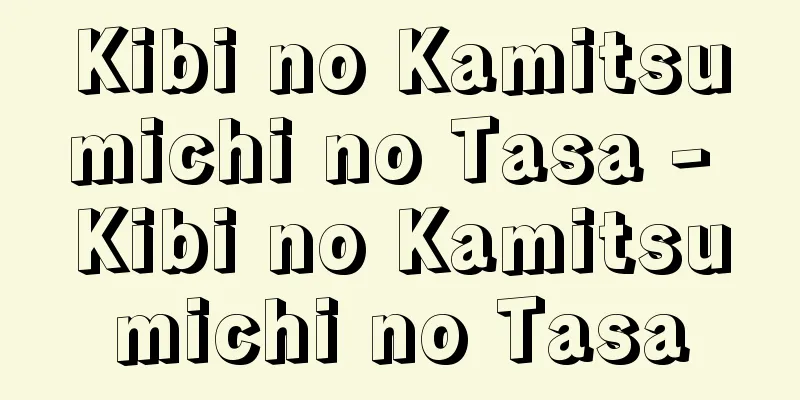Ennin - Ennin

|
A Tendai Buddhist monk in the early Heian period. His secular surname was Mibu. He was from Tsuga County, Shimotsuke Province (Tochigi Prefecture). He became a monk at the age of nine under Kochi (date of birth and death unknown) of Daiji Temple, and at the age of fifteen, he climbed Mount Hiei and studied under Dengyo Daishi Saicho. In 816 (Kōnin 7), he received the full precepts, and from 823, for twelve years, he practiced Ichigyo Zanmai (a Buddhist practice of chanting the Nembutsu) in accordance with the pure rules of Rozan. After 828 (Tencho 5), he lectured at Horyu-ji Temple, Tenno-ji Temple, and other places, and later returned to Mount Hiei, where he copied out the Lotus Sutra and placed it in a small pagoda and performed the four kinds of samadhi, which is said to be the origin of the Konpon Nyoho-do. In 838 (Jowa 5), he joined a group of Japanese envoys to China and arrived in Hailing County, Yangzhou (Jiangsu Province) in July, where he entered Kaigen-ji Temple. However, he was unable to obtain permission to make a pilgrimage to sacred sites, so he tried to return home, but was caught in a storm twice and failed. He later obtained a letter of permission, and in March 840 (Kaisei 5) on his way to Mount Wutai, he studied Zen from Xiao Qingzhong, learned the Nembutsu Sammai method, and learned Shikan from Zhiyuan (768-844) and Xuanjian. In August, he entered Zisheng Temple in Chang'an, where he learned the mysteries and rituals of the two worlds of Vajrayana and Taizo from Gensei of Daxingshan Temple, Gishin of Qinglong Temple, and Hozen (date of birth and death unknown) of Xuanpo Temple. He also learned Siddham (Sanskrit) from Hougetsu Sanzo, Tendai from Shuei of Reisenji, and secret teachings from Ryokan of Daiankokuji and Ikin of Joyo-ji. In 845, he happened to encounter the anti-Buddhist policy of Kaichang, and fled Chang'an disguised as a Taoist priest, arriving in Dazaifu in September 847 (Jowa 14). In April 854 (Jinju 4), he became the third abbot of Enryaku-ji, and in 866 (Jogan 8), he was given the posthumous name of Jikaku Daishi. Ennin introduced Tendai, Shingon, Zen, Nembutsu, and Siddham from the Tang Dynasty, bringing with him 589 volumes and 802 volumes of classic texts, but after returning to Japan he initiated Buddhist ceremonies such as the Sharie, Tendai Daishi offerings, Jodo-in temple offerings, the Uninterrupted Nembutsu Ceremony, and the Lotus Sutra Penance Ceremony, as well as promoting the Endonkai precepts and enriching esoteric Buddhism. As it is said, "The flow of Buddhism eastward is in part due to the power of the Great Master," Ennin, following Gishin, Encho (772-837), Kojo, and others, established the Tendai sect in Japan in both name and reality. His works include seven volumes of the "Commentary on the Vajrayana Sutra," seven volumes of the "Commentary on the Susiddhi Sutra," eight volumes of the "Exaltation of the Great Precepts," and four volumes of the "Records of a Pilgrimage to China in Search of the Law." [Rouen Ikeda May 19, 2017] "The Life of Jikaku Daishi, edited by Honda Tsunasuke (1962, Tendai School of Religious Studies)" "Study of Jikaku Daishi, edited by Fukui Yasutoshi (1964, Tendai Society)" [References] | | | | | |Source: Shogakukan Encyclopedia Nipponica About Encyclopedia Nipponica Information | Legend |
|
平安初期の天台宗の僧。俗姓は壬生(みぶ)氏。下野(しもつけ)国(栃木県)都賀(つが)郡の人。9歳で大慈寺(だいじじ)の広智(こうち)(生没年不詳)のもとで出家し、15歳のとき、比叡山(ひえいざん)に登り、伝教(でんぎょう)大師最澄(さいちょう)に師事した。816年(弘仁7)に具足戒(ぐそくかい)を受け、823年から12年間籠山(ろうざん)の清規(しんぎ)に従い、一行三昧(いちぎょうざんまい)(念仏行法)を修めた。828年(天長5)以後、法隆寺(ほうりゅうじ)、天王寺(てんのうじ)などで講説し、のち比叡山に帰って『法華経(ほけきょう)』を写して小塔に納め、四種三昧(ししゅざんまい)の行法を行ったが、これが根本如法堂(こんぽんにょほうどう)の濫觴(らんしょう)といわれる。838年(承和5)遣唐使の一行に加わって入唐(にっとう)、7月に揚州(江蘇(こうそ)省)海陵県に到着し、開元寺に入った。しかし霊跡巡礼のための許可を得られず帰国しようとしたが、二度も暴風にあって失敗した。その後、許可状を入手し、840年(開成5)3月、五台山に向かう途中、蕭慶中(しょうけいちゅう)から禅を学び、また念仏三昧(ねんぶつざんまい)の法を習い、志遠(しおん)(768―844)や玄鑑(げんかん)らから止観(しかん)を学んだ。8月には、長安の資聖寺(ししょうじ)に入り、長安では、大興善寺(だいこうぜんじ)の元政(げんせい)、青龍寺の義真(ぎしん)、玄法寺の法全(はっせん)(生没年不詳)らから金剛(こんごう)、胎蔵(たいぞう)両界の秘奥、儀軌(ぎき)を学んだ。そのほかにも宝月三蔵(ほうげつさんぞう)から悉曇(しったん)(梵語(ぼんご)学)を、醴泉寺(れいせんじ)の宗穎(しゅうえい)から天台を学び、大安国寺の良侃(りょうがん)や浄影寺(じょうようじ)の惟謹(いきん)からも秘法を受けたといわれる。845年たまたま会昌(かいしょう)の廃仏(仏教弾圧政策)にあい、道士の身に変えて長安を逃れ、847年(承和14)9月に大宰府(だざいふ)に到着した。854年(仁寿4)4月、延暦寺(えんりゃくじ)の第3世座主(ざす)となり、866年(貞観8)慈覚(じかく)大師の諡号(しごう)を受けた。円仁は、唐から天台、真言、禅、念仏、悉曇を伝え、589部802巻の典籍を請来したが、帰国後は、舎利会(しゃりえ)、天台大師供(く)、浄土院廟供(びょうく)、不断念仏会、法華懺法(ほっけせんぽう)などの仏事をはじめ、また円頓戒(えんどんかい)を顕揚し、密教の充実を図った。「およそ仏法の東流することは、なかばこれ大師の力なり」といわれるように、円仁は、義真、円澄(えんちょう)(772―837)、光定(こうじょう)らに次いで、名実ともに日本天台宗を大成した。著書には、『金剛頂経疏(こんごうちょうぎょうしょ)』7巻、『蘇悉地経疏(そしつじきょうしょ)』7巻、『顕揚大戒論(だいかいろん)』8巻、『入唐求法巡礼行記(にっとうぐほうじゅんれいぎょうき)』4巻などがある。 [池田魯參 2017年5月19日] 『本多綱祐編著『慈覚大師伝』(1962・天台宗教学部)』▽『福井康順編『慈覚大師研究』(1964・天台学会)』 [参照項目] | | | | | |出典 小学館 日本大百科全書(ニッポニカ)日本大百科全書(ニッポニカ)について 情報 | 凡例 |
<<: Enneades - Enneades (English spelling)
Recommend
Kakuyu - Kakuyu
A monk from the Heian period, commonly known as T...
Elanbar - Elanbar
…Also called Elanvar. An alloy mainly composed of...
Fukae Roshu
A painter from the mid-Edo period. His given name...
Jasper
A town in the western foothills of the Canadian Ro...
Kazuo Yagi
Ceramic artist. Born in Kyoto City. His father was...
African Socialist Movement
...The enthusiastic support for the "Fratern...
Leaded gasoline
Leaded gasoline is an anti-knock agent that has h...
Genkun - Veteran
Refers to people who made great contributions dur...
Fixed cost, variable cost
The costs required to produce goods and services c...
Baijia surname (English spelling)
A textbook used in China to help children learn ch...
Seventeen-Article Constitution
It is said that harmony is to be valued and that ...
Auxiliary ventilation
A method of ventilation in which a fan is installe...
Ponyova
… [Sarafan and Rubashka] Clothing was also a part...
Nyx
《 NYSE Euronext 》⇒NYSE Euronext Source: About Shog...
Tomoemon Otani
Kabuki actor. Currently there are eight generatio...









